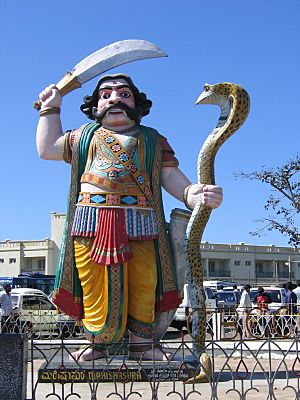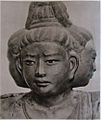Asura facts for kids

The Asura are a group of supernatural beings found in Hinduism and Buddhism. Today, many people think of Asuras as demons. However, this idea has changed over a very long time.
The concept of Asuras is ancient, going back to times before people could read or write. It took a long time for Asuras to be seen as demons. In Buddhism, Asuras also exist. They came from Hinduism but have developed their own unique meanings in Buddhist teachings.
Some Asuras are very important and have been honored for thousands of years. Two of the most important are Varuna and Mitra. Varuna is known as the god of the ocean. In ancient times, people believed the ocean flowed under the earth. This led to Varuna being seen as the god of the underworld. Water was also thought to be a source of wisdom. So, Varuna is considered very wise and shares his wisdom with those who respect him.
Mitra is Varuna's close companion. In Hinduism, "Mitra" often means "friend." But its original meaning was "promise." Because of this, Mitra is the god of friendships and promises. He protects people who are honest and punishes those who lie. The "Mi-" part of "Mitra" means "to tie tightly." This shows how friendship and promises connect people.
Asuras in Hinduism
In Hinduism, the Asura (Sanskrit: असुर) are a group of powerful beings. They are often described as looking for more power. Sometimes, they are called demons. They are known for going against the devas. Both the devas and asuras are believed to be the children of a wise man named Kashyapa.
Hinduism has many stories about Asuras and Devas fighting each other. These fights are often about who will receive the most prayers and offerings from people who worship them.
In Hinduism, Asuras are linked to moral and social ideas. These include things like truth and marriage. The Devas, on the other hand, are connected to natural things, such as the sun and the rain. In Hinduism, Asuras are sometimes thought of as "older" beings, while Devas are "younger." There are many, many Asuras and Devas. Hundreds of years ago, someone counted over 2,000 of them! Of course, not all Asuras are equally important. Some names have been forgotten, and new ones have been added over time. This is why Hinduism is called a "living religion." It is always changing and growing.
Asuras in Buddhism
In Buddhism, Asuras are partly, but not fully, demonic. Buddhism adopted the basic idea of Asuras from Hinduism.
In Buddhism, Asuras often represent negative human feelings. For example, they can stand for anger, pride, or violence. There are many different kinds of Asuras. They are usually angry and always fighting. Their leaders are called the Asurendra, which means "Lord of Asuras."
Asuras in Buddhism are very similar to humans in their emotions. On the Buddhist scale of supernatural beings, Asuras are almost at the bottom.
Buddhism is very popular in countries like Japan, China, and Korea. Because of this, many Asuras also have Japanese, Chinese, and Korean names.
Asuras in the Vedas
The Vedas are the most sacred books in Indian religions, especially Hinduism. There are four Vedas, and they are all very, very old. The oldest Veda is called the RigVeda, and it was written more than 3,000 years ago.
In the RigVeda, Asuras were not yet seen as demons. At that time, both Asuras and Devas were groups of gods. In fact, many gods in the RigVeda were called both asuras and daevas. This is because, back then, these words were not names for different groups. They were just words describing qualities. "Asura" meant "life," so gods called asuras were thought to give life. The daevas were described as shining. These were the original meanings of the names. In later books, their meanings changed, and they became names for different groups.
In the RigVeda, many Devas are called Asuras, and many Asuras are called Devas. Sometimes, they are even called both at the same time! For example, "daevic asuras" or "asuric devas." The "-ic" part connects the words. This shows that there wasn't a big difference between 'ahura' and 'daeva' in the RigVeda.
The people who wrote the Vedas spoke Sanskrit. Sanskrit is the origin of many Indian languages. The stories in the RigVeda are found in books from various North Indian peoples. They also appear in the books of some Iranian peoples, like the Zoroastrians.
One of the books of the Iranian peoples is called the Avesta. It's not just one book, but a collection of many books. The Avesta is the holy book of Zoroastrianism. The language of the Avesta is very similar to the language of the RigVeda. The Avesta also mentions Asuras and Devas. But in Iran, they are written as "ahura" and "daeva."
The oldest part of the Avesta is almost as old as the RigVeda. In this old part, the ahuras and daevas are similar to how they are in the RigVeda. In both books, they are groups of supernatural beings. However, their characters are very different.
Some time after the RigVeda was written, stories began to be told that made the Asuras and Devas enemies. A similar thing happened in the Avesta. But in the Avesta, the two groups were switched. The Asuras became demons in areas where North Indian languages were spoken. And the Daevas became demons in areas where Iranian languages were spoken.
It's not known for sure why this happened. It was a very, very long time ago.
One possible reason why Asuras became demons in India is this: After the RigVeda was written, some Indians started to think that asura meant a-sura, which could be understood as "not a hero." This might have given the asuras a bad name.
One possible reason why Daevas became demons in Iran is this: Around the same time Indians were writing the last part of the RigVeda, a wise man named Zoroaster appeared in Iran. He thought deeply about why there was good and bad in the world. He taught that Daevas could not be trusted because they couldn't tell the difference between truth and lies. Zoroaster's ideas became very popular. Over time, the Daevas became demons in Iran.
In both cases, the two sides didn't know what the other side was thinking. So, in India, only the Asuras became demons. And in Iran, only the Daevas became demons.
Many centuries before the RigVeda and before Zoroaster, a name that sounds like "Asura" was the name of a very powerful god. Some experts believe his name was "Ansu," but this isn't certain. That's why they write the name as *Ansu. The '*' means it's not fully confirmed. *Ansu was a god of life, and the names 'asura' and 'ahura' come from him. We know this god likely existed because far away in Northern Europe, there was also a god named 'Aesir', who also gave life. It's rare for the same name with the same function to appear in different places. So, 'Asura,' 'Ahura,' and 'Aesir' likely all came from '*Ansu'. This god must have been very powerful to be popular for so long.
Even though Asuras and Ahuras are related, they should not be confused. This is not only because their names are slightly different. It's also because they are very different in their roles and stories. Most importantly, they come from different cultures. Even if they came from the same place long ago, people now have very different ideas about them.
Images for kids
-
Asuras shown in the Samudra manthan carving at Angkor Wat.
See also
 In Spanish: Asura (hinduismo) para niños
In Spanish: Asura (hinduismo) para niños




